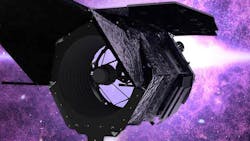Ball and NASA Team on Roman Space Telescope
Ball Aerospace & Technologies Corp. (Beavercreek, OH), working with NASA’s Goddard Space Flight Center, has completed its critical design review of the wide-field instrument (WFI) for NASA’s Nancy Grace Roman Space Telescope. Formerly known as the Wide Field Infrared Survey Telescope (WFIRST), the Roman Space Telescope uses infrared (IR) detection technology to seek out dark energy as it seeks out planets beyond our solar system. It is capable of a field of view more than 100 times that of the Hubble Space Telescope, with the same resolution.
The Roman Space Telescope (see figure) uses a 7.9-ft. (2.4-m) primary mirror for the wide field of view and efficient scanning of the IR sky. NASA scientists are estimating that the novel IR telescope has the potential to detect over a billion galaxies over the course of its mission. Dr. Makenzie Lystrup, vice-president and general manager, Civil Space, Ball Aerospace, explained: “Now that we have passed this critical milestone, we will continue to work hand-in-hand with NASA as we move from the design phase and into building and integrating the instrument. It’s always exciting to get to the hardware build, and particularly in this case as WFI is the central science instrument on Roman.”
Ball’s primary responsibility on the WFI is the opto-mechanical assembly, including the optical bench, thermal control system, optics, electronics, and calibration system. As part of working with NASA as part of an almost 60-year relationship, Ball contributed earlier on the design and development of the Hubble Space Telescope with seven different instruments along with its optical technology. NASA’s Nancy Grace Roman Space Telescope is expected to launch in the mid-2020s.
About the Author
Jack Browne
Technical Contributor
Jack Browne, Technical Contributor, has worked in technical publishing for over 30 years. He managed the content and production of three technical journals while at the American Institute of Physics, including Medical Physics and the Journal of Vacuum Science & Technology. He has been a Publisher and Editor for Penton Media, started the firm’s Wireless Symposium & Exhibition trade show in 1993, and currently serves as Technical Contributor for that company's Microwaves & RF magazine. Browne, who holds a BS in Mathematics from City College of New York and BA degrees in English and Philosophy from Fordham University, is a member of the IEEE.
